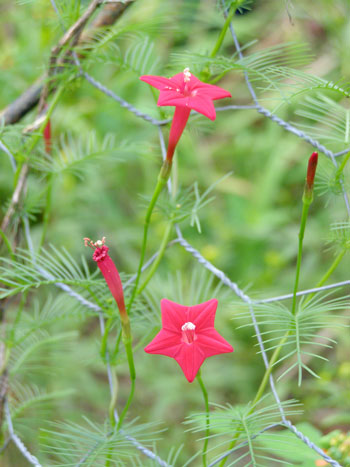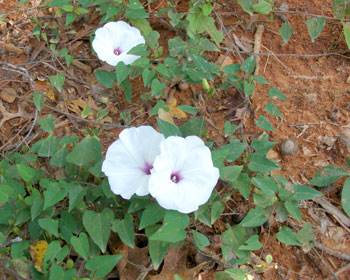Morning glory time
By Ken Moore
Flora Columnist
This is the time of year when I let the common morning glories, Ipomoea purpurea, run freely over my yard and garden. Until now, I’ve occasionally pulled the fast-growing vines from the veggies and other plants I didn’t want overwhelmed by the vigorous vines.
Now I welcome the lushness and beauty of the heart-shaped morning glory leaves climbing and hanging everywhere. Early-morning displays of pink, blue and dark purple flowers are a delight. This year, Tar Heel blue flowers have appeared on the deer fence protecting my tomatoes and okra. Tar Heel fans should be happy to have this volunteer on their home turf.
This annual vine hails from tropical America and will produce seedlings everywhere next year. I’m not a bit worried, since I’ve been managing morning glory behavior for years.

There are two other brightly colored morning glories you may find volunteering in your garden. One is cypress vine, Ipomoea quamoclit, which also originates in tropical America; the tiny, scarlet, trumpet-shaped flowers and compound leaves of numerous thread-like segments are unmistakable. The other one, also bearing brilliant red, tiny trumpets, is red morning glory, Ipomoea coccinea; it bears angular, heart-shaped leaves and is native to the southeastern U.S.
Both are annual and freely reseed each year.
Now, if you notice a white-flowered morning glory in or around your domain, you will want to take a much closer look. If the flower is large (2-4 inches) with a deep red center and the leaves are heart shaped, then you most likely have a manroot, or wild sweet potato, Ipomoea pandurata.
This plant is a native perennial with a large tuberous root and has the potential to become more aggressive than you may desire. It will continue to occur in the same spot each season, becoming more vigorous each season. Manroot has a heritage of Native-American medicinal use, and with a little searching you’ll find some suggestions for preparing the large edible, tuberous root. However, you won’t find it as delicious as the garden variety sweet potato, and you need to be aware that consumed raw or without proper preparation, those roots are mighty bitter, as in purgative.
The flowers of manroot are beautiful. I wish I had some in my landscape, but I’ve had to enjoy them as they climb up road signs and sprawl on bare road banks.
Beware of close-relative hedge bindweed, Calystegia sepium, which is a very vigorous perennial, capable of overwhelming adjacent preferred garden plants. The flower is white but lacks the deep red center of manroot, and has a leaf that’s arrow shaped with blunt or angled basal lobes.
I enjoyed discovering the red morning glory in several spots along the edge of Chapel Hill’s newly opened Morgan Creek Greenway on Labor Day. With a keen eye, you’ll discover all the other morning glories in surprising places up until frost time. One more point: their “glory†really is in the morning, so don’t expect to see them much past noontime on sunny days!
Email Ken Moore at flora@carrborocitizen.com.
Find previous Ken Moore Citizen columns at The Annotated Flora




Comments are closed.